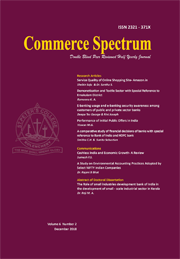Factors Affecting Green Brand Equity (GBE) of the Customers of Two and Three Wheelers: An Application of Logistic Regression
Author(s) : Dr. P.N. Harikumar, Dr. K.S. ChandrasekarVolume & Issue : VOLUME 1 / 2013 , ISSUE 1
Page(s) : 8
Abstract
The production, marketing and use of vehicles affect our natural and green environment much worse than other industries due to the pollution caused by emission and effluent of vehicles. Chemical effluent and emission from the automobile sector are harmful to our environment and the living organisms on the earth. Therefore, automobile companies are more concentrated on bringing ‘green effect’ in their production and marketing functions with the aim of getting an image as ‘green companies’. They declare that they are more socially responsible to the living organism in the green environment. They design, develop, produce and modify the structure of the vehicle by re-engineering their processes for reducing the detrimental impact on the natural and green environment. At the same time, these companies attract the prospective environmentally-conscious customers by claiming green effect in all these functions and try to satisfy the customers by launching environment-friendly vehicles in the market. Noticeably, how the various Green Marketing Practices (GMP) of these companies affect the purchasing behaviour of customers, and how they react and respond towards these practices are normally unknown to these companies. Similarly, the perception and response of the customers of automobile industries towards the GMP, the degree of satisfaction over these practices, how far the environmental effect of these vehicles affects their trust and loyalty, and finally, how far their trust and loyalty affect customers’ Green Brand Equity (GBE) are normally not predictable. In this study, the authors analyse the impact of Green Satisfaction (GS), Green Trust (GT) and Green Loyalty (GL) on the GBE of the customers of two-wheelers and three-wheelers in Kerala.
Keywords
Brand Equity, Green Brand Equity, Logistic Regression
References
Abdel-Rahman, A., (1996), Administrative Efficiency and Effectiveness: An Islamic Perspective, The Islamic Quarterly, 40, 139–154.
Ajzen, I., & Driver, B., (1992), Prediction of eisure Participation from Behavioral, Normative, and Control Beliefs: An Application of the Theory of Planned Behavior, Leisure Sciences, 13, pp. 185–191.
Anderson, J., & Gerbing, D., (1988), Structural Equation Modeling in Practice: A Review and Recommended Two-step Approach, Psychological Bulletin, 103, pp. 411–423.
Antil, J., (1984), Socially Responsible Consumers: Profile and Implications for Public Policy, Journal of Macro-marketing, 4, pp.18–39.
Bagozzi, R., Yi, Y., & Phillips,W., (1991), Assessing Construct Validity in Organizational Research, Administrative Science Quarterly, 36, pp, 421–458.
Balderjahn, I., (1988), Personality Variables and Environmental Attitudes as Predictors of Ecologically Responsible Consumption Patterns, Journal of Business Research, 17, pp. 51–56.
Bamberg, S., (2003), How does Environmental Concern Influence Specific Environmentally Related Behaviors? A New Answer to an Old Question, Journal of Environmental Psychology, 23, pp. 21–32.
Banerjee, S., Gulas, C., & Iyer, E., (1995), Shades of Green: A Multidimensional Analysis of Environmental advertising, Journal of Advertising, 24(2), pp. 21–31.
Barr, S., Ford, N., & Gilg, A., (2003), Attitudes towards Recycling Household Waste in Exeter, Devon: Quantitative and Qualitative Approaches, Local Environment, 8, pp. 407 421.
Crane, A. and Peattie, K., (1999), Has Green Marketing Failed or was it never Really Tried? Business Strategy and Environmental Conference, Leeds, September, pp. 120-129.
Danis, J, (1992), Ethics and Environmental Marketing, Journal of Business Ethics, 2(2), 81-87, pp. 122-139.
D’Souza, C., and Peretiatko, R., (2002), The Nexus between Industrialization and Environment : A Case Study of Indian Enterprises, Environmental Management and Health, 13(1), pp. 80-97.
Jain, S. K. and Kaur, G., (2003), Strategic Green Marketing : How should business Firms Go about Adopting it?, Indian Journal of Commerce, 55(4); Oct Dec : 1-16.
Titterington, A, Davis, C. and Cochsane, A., (1996), Forty Shades of Green: A Classification of Green Consumering in Northern Ireland, Journal of Euro Marketing, 5(3) : 35-43.
.png)

